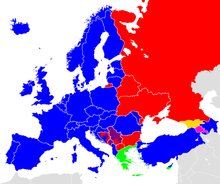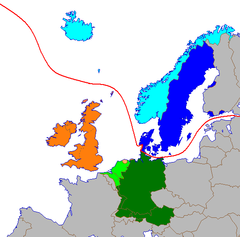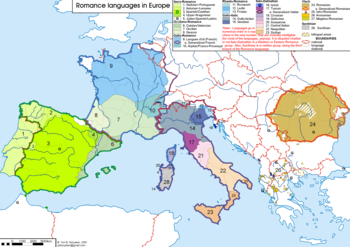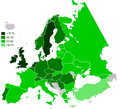| Revision as of 05:04, 3 May 2008 editBalkanFever (talk | contribs)7,052 edits nope← Previous edit | Revision as of 07:24, 4 May 2008 edit undoIzmir lee (talk | contribs)598 editsNo edit summaryNext edit → | ||
| Line 4: | Line 4: | ||
| As yet this list does not include languages spoken by relatively recently-arrived migrant communities. | As yet this list does not include languages spoken by relatively recently-arrived migrant communities. | ||
| ] | ] | ||
| [[Image:Scripts in Europe. |
[[Image:Scripts in Europe.png|thumb|right|Main alphabets used in Europe. Dark blue: latin; dark violet: mainly latin, but some regions cyrillic; red: Cyrillic; light green: Greek; turquoise: Greek and Latin | ||
| ]] | ]] | ||
Revision as of 07:24, 4 May 2008
| It has been suggested that Alphabetic list of living languages in Europe be merged into this article. (Discuss) Proposed since July 2007. |
Most of the many languages of Europe belong to the Indo-European language family. Another major family is the Finno-Ugric. The Turkic family also has several European members. The North and South Caucasian families are important in the southeastern extremity of geographical Europe. Basque is a language isolate.
As yet this list does not include languages spoken by relatively recently-arrived migrant communities.


Altaic languages

Mongolic languages
Turkic languages
Northwestern Turkic (Kypchak) languages
- Western
Southwestern Turkic (Oghuz) languages
Bolgar languages
Basque
The Basque language of the northern Iberian Peninsula is a language isolate, and as such is not related to any other language. This language may date back 7,000 years, before waves of Indo-European speaking peoples settled in Europe, but didn't penetrate the area of northern Spain and southwest France until the first millennia AD. The language is also spoken by immigrants in Australia, Costa Rica, Mexico, the Philippines, and the USA.
Finno-Ugric languages
The Finno-Ugric languages are a subfamily of the Uralic language family.
- Ugric (Ugrian)
- Finno-Permic
- Permic
- Finno-Volgaic
- Mari
- Mordvinic
- Extinct Finno-Volgaic languages of uncertain position
- Finno-Lappic
- Sami
- Western Sami
- Eastern Sami
- Kemi Sami (extinct)
- Inari Sami
- Akkala Sami (extinct)
- Kildin Sami
- Skolt Sami
- Ter Sami
- Baltic-Finnic
- Estonian
- South Estonian
- Võro (including Seto)
- Finnish (including Meänkieli or Tornedalian Finnish, Kven Finnish, and Ingrian Finnish)
- Ingrian
- Karelian
- Karelian proper
- Lude
- Olonets Karelian
- Livonian
- Veps
- Votic
- Estonian
- Sami
North Caucasian languages

Northwest Caucasian languages
Northeast Caucasian languages
South Caucasian languages
Maltese
Maltese is a Semitic language spoken in Malta and related to Arabic but written with the Latin script. It is the smallest official language of the EU in terms of speakers.
Indo-European languages
Most European languages are Indo-European languages. This large language-family is descended from a common language that was spoken thousands of years ago, which is referred to as Proto-Indo-European.
Albanian
Albanian language (also known as Shqip) is made up of two major dialects, Geg and Tosk spoken in Albania, the Republic of Macedonia, in Republic of Kosovo, Serbia, and Albanian speakers living in parts of Montenegro, also southern parts of Italy, northern part of Greece and many other European countries.
Armenian
The Armenian language is widely spoken as the majority language in Armenia. There are Armenian speakers in globally scattered communities of the Armenian diaspora in Europe, the Middle East, and the Americas (in North and South America).
Baltic languages

- Curonian
- Galindian (extinct)
- Latgalian
- Latvian
- Lithuanian
- Old Prussian (extinct)
- Samogitian
- Selonian (extinct)
- Semigallian (extinct)
- Sudovian (extinct)
Celtic languages

Brythonic
Goidelic (Gaelic)
Germanic languages
Main article: Germanic EuropeNorth Germanic
(descending from Old Norse)
- Insular Scandinavian
- Continental Scandinavian

West Germanic
German
Main article: German-speaking EuropeLow Franconian
Anglo-Frisian
Main article: English-speaking Europe- Anglo-Frisian
- Frisian
- Anglic (descending from Anglo-Saxon)
- Modern English
- Modern Scots in Scotland and Ulster
- Yola (extinct 19th century)
- Shelta (mixed with Irish)
East Germanic
- Gothic (extinct)
- Burgundian (extinct)
- Crimean Gothic (extinct in the 1800s)
- Lombardic (extinct)
- Vandalic (extinct)
Greek
- Greek: official language of Greece and Cyprus; and small Greek-speaking enclaves in Albania, Bulgaria, Italy, the Republic of Macedonia, Romania, and Turkey, and in Greek communities around the world.
Romance languages
Main article: Romance languages
The Romance languages descended from the Vulgar Latin spoken across most of the lands of the Roman Empire.
Latin is usually classified as an Italic language of which the Romance languages are a subgroup. It is extinct as a spoken language, but it is widely used as a liturgical language by the Roman Catholic Church and studied in many educational institutions. It is also the official language of Vatican City. Latin was the main language of literature, sciences and arts for many centuries and greatly influenced all European languages.
The French language is official in France, Belgium, Luxembourg, Monaco, Switzerland and the Channel Islands. It is also official in Canada, many African countries and overseas departments and territories of France.
The Italian language is official in Italy, San Marino, Switzerland, Vatican and several regions of Croatia and Slovenia.
The Romanian language is official in Romania, Moldova (as Moldovan), Mount Athos (Greece) and Vojvodina (Serbia).
The Spanish language is official in Spain. It is also spoken in the Philippines and official in most Latin American countries.
The Portuguese language is official in Portugal. It is also official in Brazil and several former Portuguese colonies in Africa and Eastern Asia (see Geographic distribution of Portuguese).
The Galician language, akin to Portuguese, is co-official in Galicia, Spain. It is also spoken by Galician diaspora (more than local population).
The Catalan language is official in Andorra, and co-official in Catalonia, Valencian Community (as Valencian), Balearic Islands and several other regions.
All of the above languages are official in the European Union and the Latin Union and they are studied in many educational institutions worldwide.
Many other Romance languages and their local varieties are spoken throughout Europe. Some of them are recognized as regional languages.
Romance languages are divided into many subgroups and dialects. For an exhaustive list, see List of Romance languages.
Indo-Iranian languages
Indo-Aryan Languages
Iranian languages
Slavic languages

West Slavic languages
East Slavic languages
South Slavic languages
- Bulgarian
- Croatian
- Old Church Slavonic
- Macedonian
- Bosnian
- Serbian
- Slovene
- Romano-Serbian (a mixed language)
General issues
Linguas Francas—past and present
Europe’s history is characterized by sixlinguas francas:
- Classical Greek then Koine Greek in the Mediterranean Basin and later the Roman Empire
- Koine Greek and Modern Greek, in the Eastern Roman or Byzantine Empire and other parts of the Balkans
- (Medieval and Neo-)Latin (from the Roman Empire until 1867, with Hungary as the last country to give up Latin as an official language apart from the Vatican City), with a gradual decline as lingua franca since the late Middle Ages, when the vernacular languages gained more and more importance (first language academy in Italy in 1582/83), in the 17th c. even at universities).
- Spanish (from the times of the Catholic Kings and Columbus, ca. 1492 (i.e. after the Reconquista, till the times of Louis XIV, ca. 1648)
- French (from the times of Cardinal Richelieu and Louis XIV, ca. 1648 (i.e. after the Thirty Years' War, which had hardly affected France, thus free to prosper), till the end of World War I, ca. 1918)
- English (mostly in its American form, since World War I and especially after World War II).
Linguas francas that were characteristic of parts of Europe at some periods:
- Latin during and after the collapse of the Roman Empire until supplanted by French and then English.
- Old French in all the western European countries (England, Italy), and in the Crusader states
- Provençal (= Occitan) (12th--14th century, due to Troubadour poetry)
- Middle Low German (14th – 16th century, during the heyday of the Hanseatic League)
- Polish (16th-18th century, because of the political, cultural, scientific and military influence of the Polish-Lithuanian Commonwealth)
- Sabir, a Romance-based lingua franca used around the Mediterranean in the Middle Ages and early Modern Age.
- German in Northern, Central, and Eastern Europe
- Russian in Eastern Europe from the Second World War to the breakup of the Soviet Union and the Warsaw Pact
First dictionaries and grammars
The first type of dictionaries are glossaries, i.e. more or less structured lists of lexical pairs (in alphabetical order or according to conceptual fields). The Latin-German (Latin-Bavarian) Abrogans is among the first. A new wave of lexicography can be seen from the late 15th century onwards (after the introduction of the printing press, with the growing interest for standardizing languages).
Language and identity, standardization processes
In the Middle Ages the two most important definitory elements of Europe were Christianitas and Latinitas. Thus language—at least the supranational language—played an elementary role. This changed with the spread of the national languages in official contexts and the rise of a national feeling. Among other things, this led to projects of standardizing national language and gave birth to a number of language academies (e.g. 1582 Accademia della Crusca in Florence, 1617 Fruchtbringende Gesellschaft, 1635 Académie française, 1713 Real Academia de la Lengua in Madrid). “Language” was then (and still ist today) more connected with “nation” than with “civilization” (particularly in France). “Language” was also used to create a feeling of “religious/ethnic identity” (e.g. different Bible translations by Catholics and Protestants of the same language).
Among the first standardization discussions and processes are the ones for Italian (“questione della lingua”: Modern Tuscan/Florentine vs. Old Tuscan/Florentine vs. Venetian > Modern Florentine + archaic Tuscan + Upper Italian), French (standard is based on Parisian), English (standard is based on the London dialect) and (High) German (based on: chancellery of Meißen/Saxony + Middle German + chancellery of Prague/Bohemia ). But also a number of other nations have begun to look for and develop a standard variety in the 16th century.
Treatment of linguistic minorities
Despite the dominance of English, Europe is always associated with its linguistic diversity, which also includes the special protection of minority languages, e.g. by the European Charter for Regional or Minority Languages. This underlines that the popular view of “one nation = one language” is mostly false, despite attempts at national linguistic homogenization in France during the Revolution or in Franco's Spain or Metaxas's Greece. A minority language can be defined as a language used by a group that defines itself as an ethnic minority group, whereby the language of this group is typologically different and not a dialect of the standard language. In Europe some languages are in quite a strong position, in the sense that they are given special status, (e.g. Basque, Irish, Welsh, Catalan, Rhaeto-Romance/Romansh), whereas others are in a rather weak position (e.g. Frisian, Scottish Gaelic, Turkish)—especially allochthonous minority languages are not given official status in the EU (in part because they are not part of the cultural heritage of a civilization). Some minor languages don’t even have a standard yet, i.e. they have not even reached the level of an ausbausprache yet, which could be changed, e.g., if these languages were given official status. (cf. also next section).
Proficiency of English, French, Spanish and German in EU
France is the origin of two laws, or decrees, concerning language: the Ordonnance de Villers-Cotterêts (1539), which says that every document in France should be written in French (i.e. not in Latin nor Occitan) and the Loi Toubon (1994), which aims to eliminate Anglicisms from official documents. An illustrative proof of the promotion of linguistic diversity is the translation school in Toledo, founded in the 12th century (in medieval Toledo the Christian, the Jewish and the Arab civilizations lived together remarkably peacefully).
This tolerant linguistic attitude is also the reason why the EU’s general rule is that every official national language is also an official EU language. However Luxembourgish for instance is not an official EU language, because there are also other (stronger) official languages with “EU status” in the respective nation. Several concepts for an EU language policy are being debated:
- one official language (e.g. English, French, German)
- several official languages (e.g. English, French, German, Italian, Spanish + another topic-dependent language)
- all national languages as official languages, but with a number of relais languages for translations (e.g. English, French, German as relais languages).
New immigrants in European countries are expected to learn the host nation's language, but are still speaking and reading their native languages (i.e. Arabic, Hindustani/Urdu, Mandarin Chinese, Swahili and Tahitian) in Europe's increasingly multiethnic/multicultural profile. But, those languages aren't native or indigenous to Europe, therefore aren't considered important in the issue of allowing them printed in European countries' official documents.
-
 Knowledge of English
Knowledge of English
-
 Knowledge of German (different scale from English)
Knowledge of German (different scale from English)
-
 Knowledge of French (same scale as German)
Knowledge of French (same scale as German)
-
 Knowledge of Spanish (same scale as German)
Knowledge of Spanish (same scale as German)
Notes
- UCLA — Language Materials Project
- cf. Jireček Line; "...Greek, the lingua franca of commerce and religion, provided a cultural unity to the Balkans... Greek penetrated Moldavian and Wallachian territories as early as the fourteenth century.... The heavy influence of Greek culture upon the intellectual and academic life of Bucharest and Jassy was longer termed than historians once believed." James Steve Counelis, review of Ariadna Camariano-Cioran, Les Academies Princieres de Bucarest et de Jassy et leur Professeurs in Church History 45:1:115-116 (March 1976) at JSTOR
- Jeroen Darquennes and Peter Nelde, "German as a Lingua Franca", Annual Review of Applied Linguistics 26:61-77 (2006)
See also
- Alphabetic list of living languages in Europe
- Eurolinguistics
- Languages of the European Union
- List of European languages by country
External links
- Languages of Europe: A map and tabulated overview over the European languages spoken in Europe made by Urion Argador
- Linguistic map of Europe in native tongues from Muturzikin.com. Priority is given to regional dialects and minority languages.
| Languages of Europe | |
|---|---|
| Sovereign states |
|
| States with limited recognition | |
| Dependencies and other entities | |
| Other entities | |
| Countries and languages lists | |||||||||||||||||
|---|---|---|---|---|---|---|---|---|---|---|---|---|---|---|---|---|---|
| |||||||||||||||||
| |||||||||||||||||